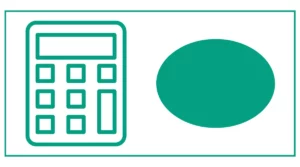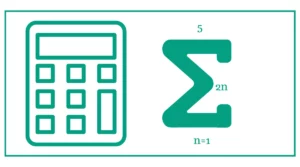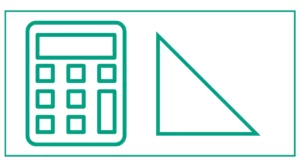Volume Of A Hemisphere Calculator
The volume of a hemisphere calculator helps you calculate hemisphere volume, total surface area, cap surface area, and base surface area.
The best thing about this hemisphere calculator is that you need to enter only one value to find the rest of them.
For example, you can enter the radius to find the diameter, surface-to-volume ratio, base surface area, cap surface area, total surface area, and volume.
Press the clear button if you want to calculate all the values from the diameter. This also applies to all other values.
In case you don’t know, the curved surface area of a hemisphere = 2𝜋r2 square units. The total surface area of a hemisphere = 3𝜋r2 square units. The volume of a hemisphere is determined by the formula (⅔)𝜋r3 cubic units.
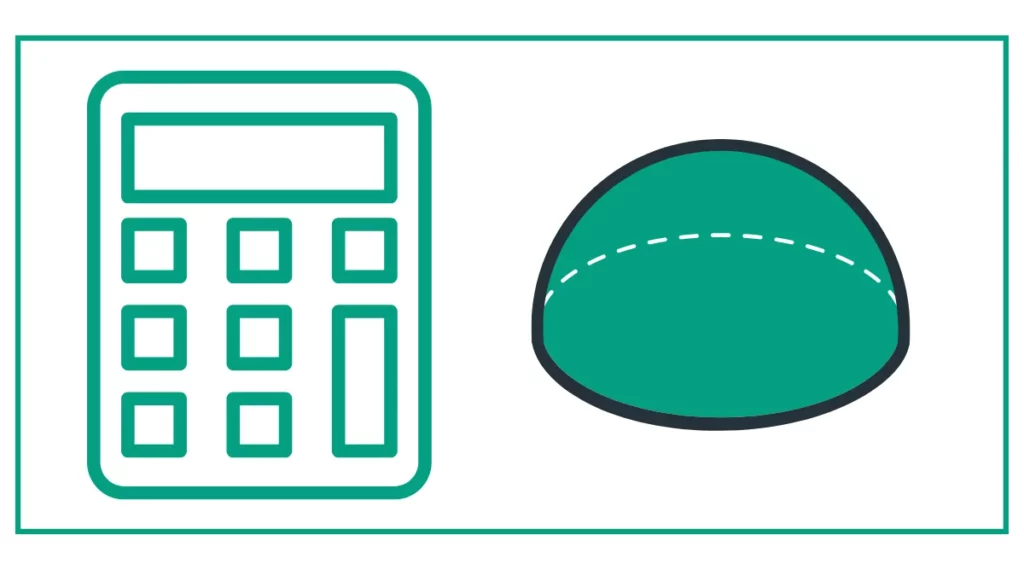
You might be interested in using a mathematical calculator.
Understanding Hemispheres: Basic Concepts
Before diving into the calculator’s specifics, let’s review some fundamental concepts about hemispheres:
- Definition: A hemisphere is half of a sphere, formed by cutting a sphere along a plane that passes through its center.
- Properties: A hemisphere inherits many properties from its parent sphere, but with some distinct characteristics due to its “half” nature.
- Key measurements: The most important measurements for a hemisphere include its radius, diameter, surface area (both curved and base), and volume.
Understanding these basics is crucial for effectively using the hemisphere calculator and interpreting its results.
Key Features of the Hemisphere Calculator
The hemisphere calculator provided is a versatile tool that allows users to calculate various properties of a hemisphere based on a single input. Let’s explore its main features:
- Multiple input options: Users can input the radius, diameter, surface-to-volume ratio, base surface area, cap surface area, total surface area, or volume of the hemisphere.
- Comprehensive output: Regardless of the input, the calculator provides all related measurements, including radius, diameter, surface-to-volume ratio, base surface area, cap surface area, total surface area, and volume.
- User-friendly interface: The calculator features a clean, easy-to-use design with clearly labeled input fields and buttons.
- Real-time calculations: Results are updated instantly as users input or change values, allowing for quick comparisons and analyses.
- Clear functionality: A “Clear” button allows users to reset all fields, making it easy to start new calculations.
How to Use the Hemisphere Calculator
Using the hemisphere calculator is straightforward. Follow these steps to get the most out of this tool:
- Choose your input: Decide which measurement you want to use as your starting point. This could be the radius, diameter, surface-to-volume ratio, or any of the surface areas or volume.
- Enter the value: Input the known value into the corresponding field. Make sure to use the correct units (centimeters for length measurements, square centimeters for areas, and cubic centimeters for volume).
- Click “Calculate”: Press the “Calculate” button to generate results for all other properties of the hemisphere.
- Review the results: The calculator will display values for all properties, allowing you to see how they relate to each other.
- Experiment: Try inputting different values or using different properties as your starting point to gain a deeper understanding of how hemisphere measurements relate to each other.
- Clear and repeat: Use the “Clear” button to reset all fields when you want to start a new calculation.
Understanding the Formulas Behind the Calculator
To appreciate the power of the hemisphere calculator, it’s essential to understand the formulas it uses. Here are the key equations employed by the calculator:
- Radius (r) and Diameter (d):
d = 2r - Surface-to-Volume Ratio (SVR):
SVR = 9 / (2r) - Base Surface Area (BSA):
BSA = πr² - Cap Surface Area (CSA):
CSA = 2πr² - Total Surface Area (TSA):
TSA = 3πr² - Volume (V):
V = (2/3)πr³
These formulas are interrelated, allowing the calculator to derive all properties from any single input. Understanding these relationships can help you better interpret the calculator’s results and apply them in real-world scenarios.
Practical Applications of the Hemisphere Calculator
The hemisphere calculator has numerous practical applications across various fields. Here are some examples:
- Architecture and Construction: Architects and builders can use the calculator to determine the amount of material needed for domed structures or to calculate the volume of hemispherical tanks or containers.
- Engineering: Engineers working on spherical or hemispherical components can quickly calculate surface areas for coating applications or volumes for fluid capacity.
- Education: Students and teachers can use the calculator to explore geometric relationships and visualize how changing one property affects others.
- Manufacturing: In industries producing hemispherical products, the calculator can help determine material requirements and assess product specifications.
- Scientific Research: Researchers studying phenomena related to hemispheres (e.g., in astronomy or meteorology) can use the calculator to perform quick calculations and conversions.
Example 1: Designing a Hemispherical Dome
Let’s consider a practical example of how the hemisphere calculator can be used in architecture. Imagine an architect is designing a hemispherical dome for a new planetarium. They need to determine various measurements to plan the construction and estimate materials needed.
Given information:
- The dome’s diameter needs to be 30 meters to accommodate the required seating capacity.
Step 1: Enter the diameter
Input 3000 cm (converting 30 meters to centimeters) into the “Diameter” field of the calculator.
Step 2: Calculate
Click the “Calculate” button to generate all other measurements.
Step 3: Analyze the results
The calculator will provide the following information:
- Radius: 1500 cm
- Surface-to-Volume Ratio: 0.003 1/cm
- Base Surface Area: 7,068,583.47 cm²
- Cap Surface Area: 14,137,166.94 cm²
- Total Surface Area: 21,205,750.41 cm²
- Volume: 7,068,583,470.58 cm³
Step 4: Apply the results
With these calculations, the architect can now:
- Determine the amount of material needed to cover the dome’s surface (21,205,750.41 cm² or about 2,120.58 m²)
- Calculate the volume of air that needs to be conditioned inside the dome (7,068,583,470.58 cm³ or about 7,068.58 m³)
- Plan for the base structure that needs to support a circular area of 7,068,583.47 cm² (about 706.86 m²)
This example demonstrates how the hemisphere calculator can quickly provide all necessary measurements from a single known value, significantly streamlining the design and planning process.
Example 2: Calculating Paint Required for a Hemispherical Tank
In this example, we’ll use the hemisphere calculator to determine the amount of paint needed to coat the exterior of a hemispherical water tank.
Given information:
- The tank has a radius of 2 meters.
- The paint coverage is 10 m² per liter.
Step 1: Enter the radius
Input 200 cm (converting 2 meters to centimeters) into the “Radius” field of the calculator.
Step 2: Calculate
Click the “Calculate” button to generate all other measurements.
Step 3: Analyze the results
The calculator will provide the following information:
- Total Surface Area: 377,991.12 cm²
Step 4: Calculate the paint required
Convert the total surface area to square meters: 377,991.12 cm² = 37.80 m²
To find the amount of paint needed, divide the surface area by the paint coverage:
Paint required = 37.80 m² ÷ 10 m²/L = 3.78 L
Therefore, approximately 3.78 liters of paint are needed to coat the exterior of the hemispherical tank.
This example shows how the hemisphere calculator can be used in practical scenarios to quickly determine material requirements, saving time and reducing the likelihood of calculation errors.
Limitations
While the hemisphere calculator is a powerful tool, it’s important to be aware of its limitations and consider certain factors when using it:
- Unit consistency: The calculator assumes all inputs are in centimeters (cm). If you’re working with different units, you’ll need to convert them before inputting values and convert the results back to your desired units.
- Precision: The calculator displays results to two decimal places. For applications requiring higher precision, you may need to perform additional calculations or use more specialized tools.
- Real-world variations: The calculator assumes a perfect hemisphere. In practice, objects may have slight imperfections or variations that could affect the accuracy of calculations.
- Material considerations: When using the calculator for practical applications (like in our painting example), remember to account for factors such as material waste, overlap, or multiple coats that may affect the final quantities needed.
- Contextual understanding: While the calculator provides accurate numerical results, it’s crucial to interpret these results in the context of your specific application or problem.
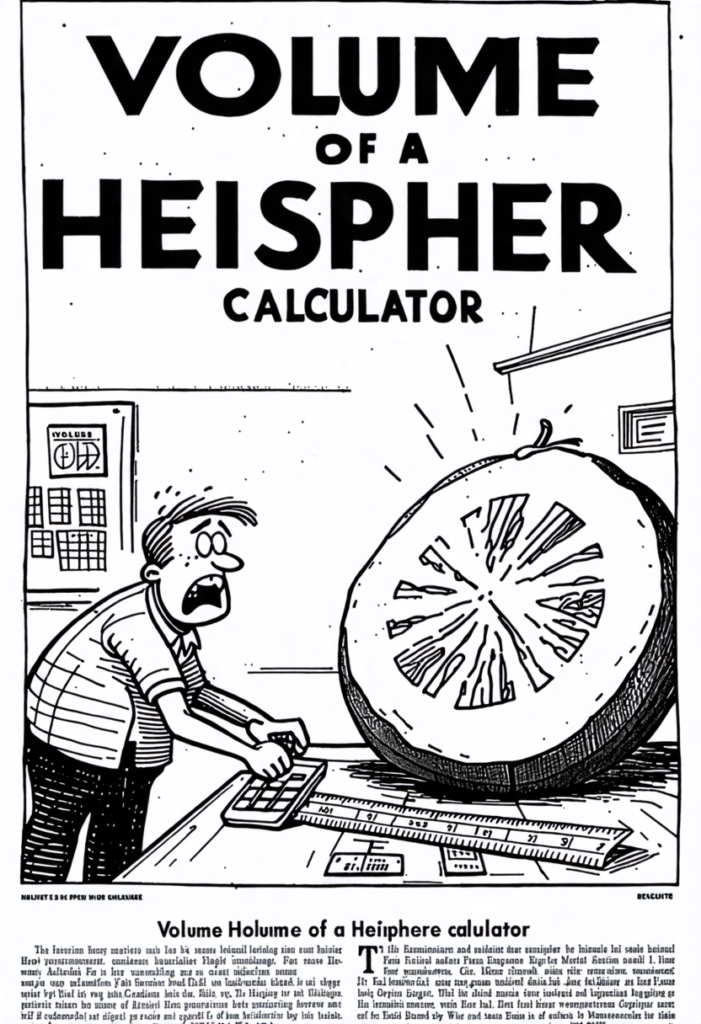
References
- Foundation, C. (n.d.). CK12-Foundation. CK12-Foundation. flexbooks.ck12.org/cbook/ck-12-cbse-math-class-9/section/13.12/primary/lesson/surface-area-and-volume-of-a-hemisphere-and-spherical-shell/
- G. (2023, January 9). Volume Of Hemisphere: Formula, Definition, Derivation – Getmyuni. Getmyuni. getmyuni.com/articles/volume-of-hemisphere


